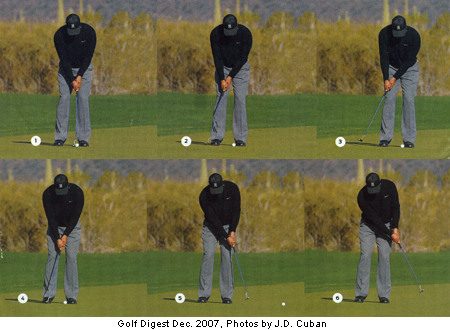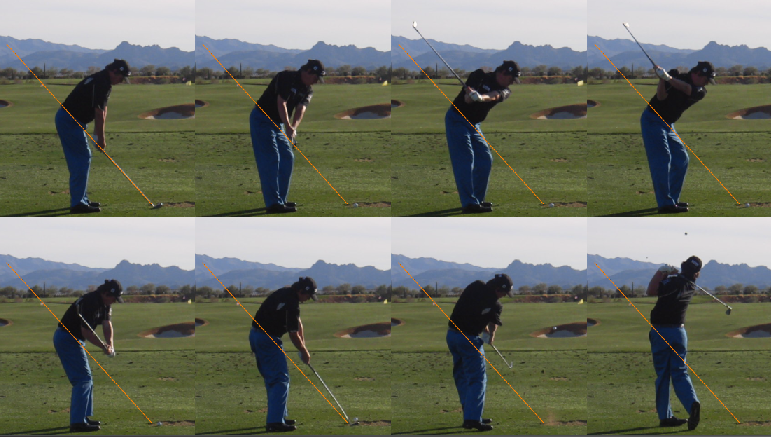 A pendulum swings around a fixed point and in order to release the face of the putter correctly, so should your putting stroke.
A pendulum swings around a fixed point and in order to release the face of the putter correctly, so should your putting stroke.
Jim Hardy, the noted 'One-Plane' teacher, has gone on record as stating that the majority of great putters are invariably 'hookers' of the golf ball in their full swing. They all release the putter face the same way they release their club face - aggresively! And when looking at a sampling of the greatest of all time; Faxon, Crenshaw, Locke (as in Bobby!), George Archer and Ballesteros; I certainly can concur with his reasoning. Of course Jack and Tiger aren't too bad but let's just stick with the formula for now!
In order for the face to release the stroke needs to work like a pendulum. Notice in the pictures of Tiger Woods above how the butt end of the putter in each frame points at the same spot on his torso. So often I see golfers, in an attempt to not use their wrists, push the hands through the stroke, thus discouraging the wrists, hands and face to release freely. This leads not only to poor direction and ball striking, but most importantly decreased distance control.
An excellent little teaching aid to overcome this common flaw is the Perfect Pendulum. This device attaches to your own putter and telescopes up into your belly. (Unless your belly happens to telescope into it!) Once it's anchored make a few strokes to get a sense of the putter head swinging beyond the hands into the follow through. It ensures a correct release.
I love simple teaching aids that convey the correct feel while using your own club and this one takes care of everything for you!
Here are a few keys to remember:
- Assume your normal address position and note where the butt end of the putter points.
- As you stroke try to sense the butt end pointing at the same spot on your upper body. This should be maintainted from address to the back of the stroke and on into the follow through.
- Feel the putter head SWING to either side of your center.
- A light, soft grip will aid in the putter face releasing freely.
- Roll a few putts with your dominant hand only to feel the correct rhythm of the stroke.
For better distance and direction (is there anything else?) with your putting try these ideas. They will help!
Things to Ponder:
- John Daly's career can be marked by either upward or downward trends. Over the past few years the lows are lower and the highs are not quite where they once were. He is clearly on an upward trend at the moment, I just hope he has the sense to survive the next low.
- I have had a few responses to my All-time Heart List. After reconsideration, I must add Lee Trevino and Tiger Woods to the list. Tom Watson is waiting in the wings.
- Why do Davis Love and Ben Crane have to qualify for the British Open? They are both in the top 60 players in the world and are both having relatively good seasons.
- It's about time Vijay Singh has showed up again on a leaderboard! Where has he been?
Thanks for reading and please feel free to make abusive comments about the author.












